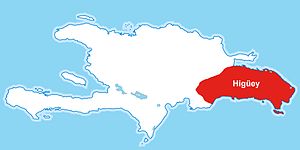User:MashMixon/Cotubano

Cotubano (Cotubanama) (d. 1503) - one of the five supreme caciques (chiefs) of the Taino Indian tribe on the island of Española (Haiti, Hispaniola). Ruler of the Iguay region.
Iguay means "place where the sun is born" in the language of the local Indians. The local Indians, led by the cacique Cotubano, were armed, like the Caribs (Kalinago), with bow and arrow and resisted the Spanish more staunchly than many other Indians on the island.
When the Spanish governor, Nicolás de Ovando, receives the news that the garrison of Fort Higuey was killed by the rebel Indians and only one person was saved, he orders Captain Juan de Esquivel to conduct a punitive expedition to the east of the island with forces of 300-400 Spaniards under the command of Lieutenants Juan Ponce de Leon and Diego de Escobar, as well as auxiliary detachments of conquered Indians.
The historian of the Conquista Bartholomé de Las Casas reports:
"They found Indians there who were ready to fight and defend their land and their settlements, but, alas, their capabilities did not correspond to their aspirations; and since all their wars resembled children's games, and the shield they put up to meet the arrows and bullets fired by the Spaniards from crossbows and rifles served their own belly, and they fought naked, and their weapons were only a bow and unpoisoned arrows, and stones (where they were), of course, the Indians were not able to seriously resist the Spaniards, whose weapons were iron, whose swords cut the Indian in half and whose muscles and hearts were made of steel, not to mention the riders, each of Who could have killed 2,000 Indians in one hour. And so, after a short resistance in the villages, when their troops were defeated and the number of killed grew, and the rest were exhausted and could no longer resist the hail of arrows and bullets and endure the blows of swords in close combat, their whole war was reduced to the fact that they fled to the forests and mountains and hid in the thickets. When they went to the mountains, the Spanish troops went to hunt them and, caught them with their wives and children, without knowing any pity, killed men and women, children and the elderly as they slaughter and kill lambs in the slaughterhouse. The Spaniards, as already mentioned, had a rule in wars with the Indians to behave not as they wanted, but to show incredible, monstrous cruelty, so that the Indians would never cease to feel fear and bitterness from the unfortunate life they had to lead because of the Spaniards, and so that they would not feel like people for a moment; and many of those who were seized by the Spaniards cut off both hands and, tying the cut off limbs to their shoulders, said: "Well, go and carry these letters to your wives," which meant "tell them about yourself this news." On many Indians, they tried the sharpness of their swords and competed with each other, whose sword is the sharpest or the hand is the strongest, and cut a man in two or with one blow took his head off his shoulders and wanger about it".
The Spanish punitive expedition took about ten months before Supreme Chief Cotubano was captured and executed, and this territory was completely cleared by the Spaniards. "The rebellious chief Cotubanama, whose heroic courage terrified the Spaniards when he saw that there was no salvation, and his soldiers were dying one after another, fled to the island of Saonu, located near the coast of Iguey. There he hid for several days until, despite desperate resistance, he was captured by the soldiers of Juan de Esquiville. Previously, conquistador Juan de Esquivel was Cotubano's brother. When the cacique was brought to the city of Santo Domingo, the winner, obviously driven by the memory of friendship, asked to save his life. But Governor Nicholas de Ovando gave the order to hang him in the square.
References[edit]
- Josefina Oliva de Col. Resistance of Indians to Spanish Conquistadors. - M.: "Progress", 1988. - Art. 47 - 49. - ISBN 5-01-001087-9.
[[Category:History of Haiti]] [[Category:15th-century births]]
